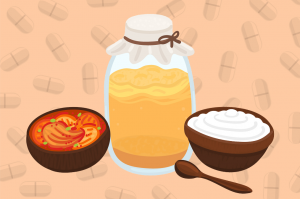Antibiotics are used to target and kill harmful bacteria when you have an infection that’s making you sick. And, when the right one is chosen, taking an antibiotic can be lifesaving—not to mention that they can significantly improve painful or annoying symptoms within 24 to 48 hours. But antibiotics aren’t without a downside. Here’s how antibiotics may impact your gut health and what foods help you restore it.
How Antibiotics Impact Your Gut Health
Along with killing off harmful bacteria, antibiotics inadvertently kill off some”good” bacteria in your gut in the process. If enough beneficial bacteria are lost, the diversity and ratio of good-to-bad microbes starts to shift slowly, leading to unhealthy changes in the overall bacterial composition of the gut.
Stronger, more targeted antibiotics often come with a label advising consumption of probiotic-rich foods like yogurt while taking them, and the purpose of this is to repopulate the gut with good bacteria to circumvent or lessen negative changes in the gut. But consuming probiotic-rich foods is a good idea in most cases, even when the antibiotic isn’t quite as strong or doesn’t have this label. In fact, according to a 2019 systematic review published, even broad-spectrum, commonly prescribed antibiotics such as amoxicillin lead to changes in gut microbe composition. And the big concern at the center of this is what we’re gradually learning about the potential influence that gut microbes have on our long-term health and disease risk.
What Research Says About the Benefits of Probiotics
Consuming probiotic-rich foods and drinks is one of the best ways to support gut health, particularly when taking antibiotics. In fact, a review published in 2019 suggests that consuming probiotics while also taking a round of antibiotics can improve and potentially even restore the microbiota afterward. And fermented food and drink products are the best natural source. This is because most probiotics—those living, beneficial bacteria—are created through the fermentation process. While yogurt is the go-to probiotic food often recommended, most fermented foods help to repopulate and rebalance the gut’s microbial makeup. This means that, in addition to fermented dairy products like yogurt and kefir, fermented plants or cultures used to make kimchi, kombucha, sauerkraut, miso and tempeh are also great probiotic sources.
Results of 10-week clinical trial at Stanford University, demonstrated just how beneficial consuming fermented food and drink can be. The researchers randomly divided healthy subjects into two groups: one group that consumed fermented foods or beverages each day and one group that consumed high-fiber (prebiotic-rich) foods each day. Both groups had comparable gut makeups prior to starting, and all individuals gradually increased their intake of either fermented or high-fiber foods over the 10 weeks. However, only the subjects in the fermented products group exhibited a significant increase in new bacteria strains and gut diversity, outcomes often seen as indicators of a healthy gut. Even better, these positive changes remained at follow-up, when the subjects’ fermented food intake was no longer being monitored.
How Much Fermented Food to Eat
So we know that probiotics can boost your gut health, but exactly how much fermented food and drink should you consume when taking antibiotics? No precise daily or weekly amount has been established. But here’s what is known, to help guide you.
Regularly consuming fermented, probiotic-rich foods and beverages appears to be beneficial to overall gut health for most individuals, regardless of their current gut-health status.
Consuming fermented, probiotic-rich foods and beverages appears to be an effective and safe way to prevent or lessen gut composition changes when taking an antibiotic for most people. Immune-compromised individuals are encouraged to check with their health care provider first.
Daily consumption of fermented foods and beverages appears to be optimal in terms of promoting gut health in healthy individuals, so one can assume that daily consumption is a good goal when an antibiotic is added too.
Increase fermented food and beverage intake gradually. In the Stanford study, participants started by consuming 1/2 serving to 1 serving of fermented foods and beverages each day and then were challenged to increase to up to 6 servings by the end of the 10 weeks. A good goal is to incorporate fermented foods into your diet on a regular basis. Then, you may consider upping that intake by 1/2 to 1 1/2 servings each day when taking an antibiotic.
Serving size varies among probiotic foods and beverages. In the study, one serving was defined as:
¾ cup (6 oz.) of kombucha, yogurt or kefir
¼ cup of kimchi, sauerkraut or other fermented vegetable
¼ cup (2 oz.) of vegetable brine drink
Also, don’t be afraid to eat half-servings and to mix-and-match fermented sources to reach your daily or weekly fermented-foods goal. Your health care provider or a registered dietitian can help you figure out the right goal for you!
Post time: Aug-12-2022





